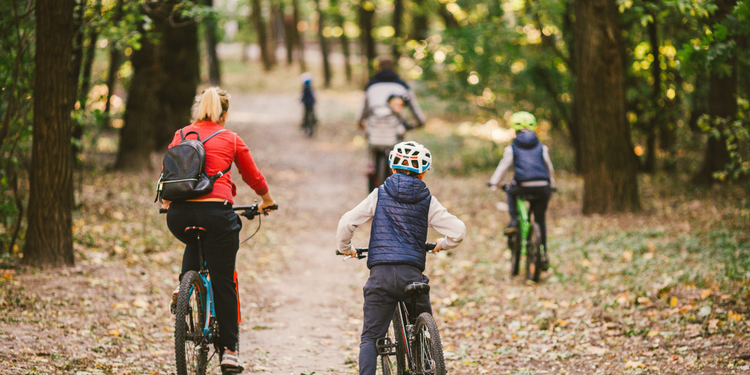Cycling with children this Easter?
Here are our Top Ten Tips to make it stress-free and fun!
As well as an abundance of chocolate, Easter brings the promise of warmer weather and the opportunity to dust the bikes off and get out with the children.
Whether you have some experience biking with little ones or are new to it, here are our top ten tips for ensuring your Easter cycling sessions with the kids are as enjoyable as possible.
Tip 1: Make sure bikes are the right size
Ensuring the bike they’ll be riding is the correct size for the child is an essential step for safety and comfort reasons.
To establish the correct size bike for your child, measure the inside of their leg and use this measurement to determine the appropriate wheel size needed.
You’ll also likely need to make some adjustments to whichever bike they’ll be using. This can involve anything from adjusting the saddle height to ensuring the handlebars are the correct distance from the seat.
Tip 2: Teach children the rules of the road
When cycling with children, parents and guardians are responsible for their safety, including teaching them the rules of the road.
Educating children on the basics of traffic safety is essential, from always looking left and right before crossing the street, using hand signals, riding in the same direction as the traffic, and knowing and obeying traffic signs.
Children must also be taught the critical importance of wearing a bicycle helmet every time they ride. As well as helmets, children must learn to wear bright and reflective clothing and the basics of bicycle maintenance.
Tip 3: Choose safe routes
It is always better to choose safe bike ride routes, but it is vital when children are involved. This means avoiding busy roads and intersections with a greater risk of traffic and other hazards.
It is generally safer to use designated bike paths and trails as these are designed specifically for cyclists and will be easier for children to navigate. Either way, make sure that the route is not too long as children often tire before adults, so keep the length of the journey in mind.
Tip 4: Make it fun!
One of the best ways to ensure a great cycling experience for children is to make it fun. Children love to play, so incorporating games and activities into their cycling experience can make the ride much more enjoyable.
This could include setting up an obstacle course or challenging them to complete a certain number of laps within a given timeframe. Planning interesting routes can also keep them engaged and motivated. If possible, try to find trails with lots of scenery or perhaps a spot of wildlife spotting.
Ultimately, you want to find ways to make the ride enjoyable and memorable, and for this, there is little else children enjoy more than stopping off somewhere scenic to have a picnic.
Tip 5: Reward good behaviour
Rewarding good behaviour helps children learn how to cycle safely. Though setting expectations and consequences ahead of time can help children understand the importance of following the rules, offering rewards for good behaviour is an effective means of encouraging children to continue cycling safely and responsibly.
For example, if a child follows the rules of the road and completes a ride without any issues, they could be rewarded with a small treat to promote the idea that following the rules results in positive outcomes.
Tip 6: Let them take control
Though children like and depend on a sense of structure and leadership provided by adults in most aspects of their life, they also enjoy taking control of situations. Cycling affords the perfect opportunity to let them do so.
When on the roads, adults must always take the lead. However, if you can take your bikes to a wide, open space such as a park, the beach, or a large field, allowing the child to dictate the directions you travel is safe.
Not only will they get a thrill from leading the grown-ups, but it will also give them confidence before they are old enough to ride solo.
Tip 7: Bring a friend
Particularly where children are concerned, 'the more, the merrier' very much applies to cycling.
If you're planning a bike ride with just one child, ask them if they want to invite a friend. Apart from enjoying the company of similarly aged companions, they’ll learn that cycling is a communal pastime and that playing with friends can involve physical activity as well as sitting in front of a games console!
Tip 8: Take pictures and videos
Cycling with children is a wonderful experience. As it is all still so new to them, their sense of joy at being out in the open on a set of wheels is as infectious as it is unforgettable.
Nevertheless, children’s memories do fade as they enter adulthood. Documenting your rides with photographs and videos means they (and you) can revisit your experiences as often as you like.
Tip 9: Don’t forget water
It’s always good to have some supplies about your person on a bike ride as those burnt calories will need to be periodically topped up. A sweet treat is also a nice reward following an especially long ride.
Water, however, is a necessity rather than a luxury. If children become dehydrated during a ride, it will spoil their experience and could even put them off cycling. Always bring a bottle of water and stop for regular breaks to rehydrate.
Tip 10: Celebrate afterwards
In our digital age, where children rack up so much screen time, any sustained period of physical activity should be met with reward.
Consider ending your plan for the day with a special treat, such as a meal out at the child's favourite restaurant or letting them stay up an extra hour at the weekend.
If you’re considering taking the family bike rides further than just your doorstep, it may be time to invest in a family bike rack or trailer. We have a range of solutions and are always happy to advise on the right product for you and your family. Let’s have a chat.

